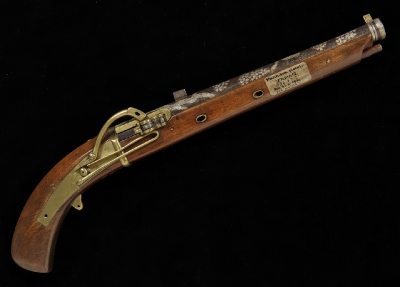Bajouzutsu (1934.67.12)
Until recent times, Japanese guns were colloquially referred to as tanegashima, named after the island in southern Japan where the Portuguese landed in 1543 and introduced firearms technology to the local craftsmen. Domestic firearms production spread rapidly throughout Japan and revolutionized battle strategies hitherto dominated by bows and arrows, catapults, and pole weapons.
Matchlock muskets continued to be made and used in Japan until the end of the Edo period c. 1870. Matchlocks tend to be long-guns, and handguns (bajouzutzu, meaning 'horsemen's cannons') using this mechanism were virtually unknown outside Japan. Designed to be used on horseback, this ornate example has a brass lock and an iron barrel damascened with floral and bird designs. In practical terms bajouzutzu were difficult to use as the rider had to light the match at the same time as controlling his horse but nonetheless, they remained a symbol of rank, power and wealth.





